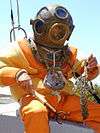Seasickness
| Seasickness | |
|---|---|
| Classification and external resources | |
| Specialty | emergency medicine |
| ICD-10 | T75.3 |
| ICD-9-CM | 994.6 |
The phenomenon of seasickness is a form of motion sickness characterized by a feeling of nausea and, in extreme cases, vertigo, experienced after spending time on a craft on water.[1]
Causes
This condition is caused by the rocking motion of the craft.[2] Most people tend to concentrate on the inner surroundings, or close the eyes and try to sleep. This will cause the worst effect of the disturbance.
The brain receives conflicting signals: while the eyes show a world that is still, our body, and in particular the equilibrium sensors located in our ears, send signals of a moving environment. This discordance causes the mind to send to the whole body a general alarm signal, in order to stop all activities, in particular the most complex of all, the digestion process.[3]
Solution
Generally, the disturbance will cease once the visual and motion stimuli are synchronized. This can be obtained by concentrating on the horizon until things appear fixed and horizontal. This is the signal that our vision has switched from the reference system of the boat to the reference system of the Earth. Fisherman and other boat users have their own anecdotal solutions including moving to the part of the vessel that has the least movement and cleanest air. Avoiding certain foods and drinks (alcoholic) are also talked about as potentially preventative measures.
Alias
The same syndrome: interruption of digestive process, nausea, headache, vertigo, may happen in other conditions and may bear the same name, erroneously. In scuba diving, while happening deep in the sea, so called seasickness is not caused by motion sickness, but by unusual pressure, temperature, stance and medium. Equal syndrome may be experienced hiking at high altitudes.
Remedy
Over-the-counter medications such as Cinnarizine/Stugeron and prescription medications such as dimenhydrinate,[4] scopolamine[5] and promethazine[6] (as transdermal patches and tablets) are readily available. As these medications often have side effects, anyone involved in high-risk activities while at sea (such as SCUBA divers) must evaluate the risks versus the benefits.[7][8][9][10][11] Promethazine is especially known to cause drowsiness, which is often counteracted by ephedrine in a combination known as "the Coast Guard cocktail.".[12] There are special considerations to be aware of when the common anti-motion sickness medications are used in the military setting where performance must be maintained at a high level.[13]
See also
References
- ↑ Benson, Alan J. (2002). "Motion Sickness". In Kent B. Pandoff; Robert E. Burr. Medical Aspects of Harsh Environments (PDF). 2. Washington, D.C.: Borden Institute. pp. 1048–1083. ISBN 978-0-16-051184-4. Retrieved 4 Dec 2012.
- ↑ Shri Kamal Sharma (1 January 1992). Resource Utilization and Development: A Perspective Study of Madhya Pradesh, India. Northern Book Centre. pp. 1078–. ISBN 978-81-7211-032-1. Retrieved 30 June 2013.
- ↑ Robert William Baloh; Vincente Honrubia (2001). Clinical Neurophysiology of the Vestibular System. Oxford University Press. pp. 127–. ISBN 978-0-19-513982-2. Retrieved 30 June 2013.
- ↑ Weinstein SE, Stern RM (October 1997). "Comparison of marezine and dramamine in preventing symptoms of motion sickness". Aviation, Space, and Environmental Medicine. 68 (10): 890–4. PMID 9327113.
- ↑ Spinks AB, Wasiak J, Villanueva EV, Bernath V (July 2007). Wasiak J, ed. "Scopolamine (hyoscine) for preventing and treating motion sickness". Cochrane Database of Systematic Reviews. 18 (3): CD002851. doi:10.1002/14651858.CD002851.pub3. PMID 17636710.
- ↑ "Phenergan information". Drugs.com. Retrieved 2009-07-10.
- ↑ Schwartz, Henry JC; Curley, Michael D (1986). "Transdermal Scopolamine in the Hyperbaric Environment". United States Navy Experimental Diving Unit Technical Report. Retrieved 2008-05-09.
- ↑ Lawson et al. (2009) Evaluation of Several Common Antimotion Sickness Medications and Recommendations Concerning Their Potential Usefulness During Special Operations. http://oai.dtic.mil/oai/oai?verb=getRecord&metadataPrefix=html&identifier=ADA511823
- ↑ Bitterman N, Eilender E, Melamed Y (May 1991). "Hyperbaric oxygen and scopolamine". Undersea Biomedical Research. 18 (3): 167–74. PMID 1853467. Retrieved 2008-05-09.
- ↑ Williams TH, Wilkinson AR, Davis FM, Frampton CM (March 1988). "Effects of transcutaneous scopolamine and depth on diver performance". Undersea Biomedical Research. 15 (2): 89–98. PMID 3363755. Retrieved 2008-05-09.
- ↑ Arieli R, Shupak A, Shachal B, Shenedrey A, Ertracht O, Rashkovan G (1999). "Effect of the anti-motion-sickness medication cinnarizine on central nervous system oxygen toxicity". Undersea and Hyperbaric Medicine. 26 (2): 105–9. PMID 10372430. Retrieved 2008-05-09.
- ↑ East Carolina University Department of Diving & Water Safety. "Seasickness: Information and Treatment" (PDF).
- ↑ Lawson, B. D., McGee, H. A., Castaneda, M. A., Golding, J. F., Kass, S. J., & McGrath, C. M. (2009). Evaluation of Several Common Antimotion Sickness Medications and Recommendations Concerning Their Potential Usefulness During Special Operations (No. NAMRL-09-15). NAVAL AEROSPACE MEDICAL RESEARCH LAB PENSACOLA FL.
